2016 JEEP GRAND CHEROKEE coolant level
[x] Cancel search: coolant levelPage 302 of 745

WARNING!
A hot engine cooling system is dangerous. You or
others could be badly burned by steam or boiling
coolant. You may want to call an authorized dealer
for service if your vehicle overheats. If you decide to
look under the hood yourself, see “Maintaining Your
Vehicle”. Follow the warnings under the Cooling
System Pressure Cap paragraph.
5. Fuel Gauge •The pointer shows the level of fuel in the fuel tank
when the ignition is in the ON/RUN position
•
The fuel pump symbol points to the side of the
vehicle where the fuel door is located. WARNING AND INDICATOR LIGHTS
IMPORTANT:
The warning / indicator lights switch on
in the instrument panel together with a dedicated mes-
sage and/or acoustic signal when applicable. These
indications are indicative and precautionary and as such
must not be considered as exhaustive and/or alternative
to the information contained in the Owner ’s Manual,
which you are advised to read carefully in all cases.
Always refer to the information in this chapter in the
event of a failure indication.
All active telltales will display first if applicable. The
system check menu may appear different based upon
equipment options and current vehicle status. Some
telltales are optional and may not appear.
300 UNDERSTANDING YOUR INSTRUMENT PANEL
Page 667 of 745
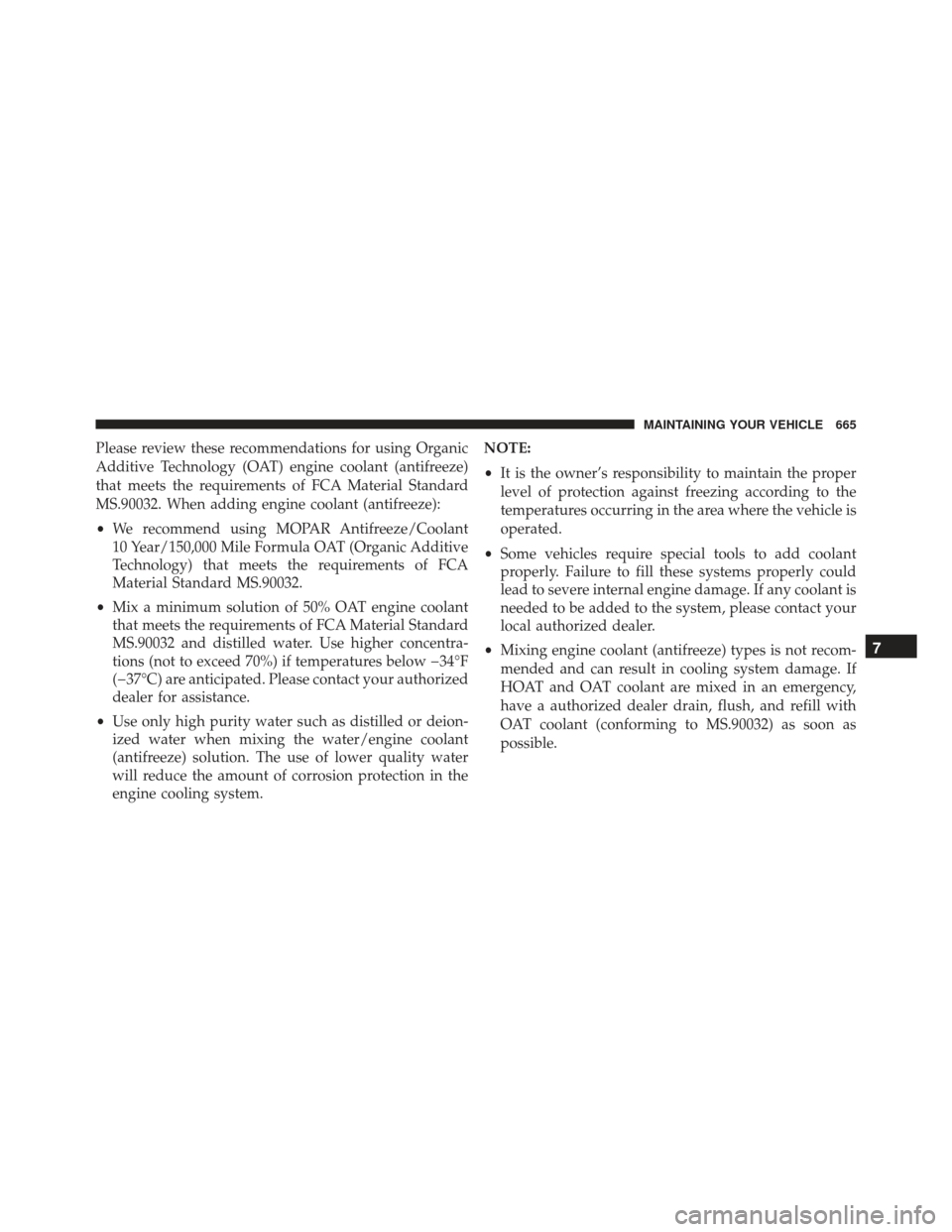
Please review these recommendations for using Organic
Additive Technology (OAT) engine coolant (antifreeze)
that meets the requirements of FCA Material Standard
MS.90032. When adding engine coolant (antifreeze):
•We recommend using MOPAR Antifreeze/Coolant
10 Year/150,000 Mile Formula OAT (Organic Additive
Technology) that meets the requirements of FCA
Material Standard MS.90032.
• Mix a minimum solution of 50% OAT engine coolant
that meets the requirements of FCA Material Standard
MS.90032 and distilled water. Use higher concentra-
tions (not to exceed 70%) if temperatures below �34°F
(�37°C) are anticipated. Please contact your authorized
dealer for assistance.
• Use only high purity water such as distilled or deion-
ized water when mixing the water/engine coolant
(antifreeze) solution. The use of lower quality water
will reduce the amount of corrosion protection in the
engine cooling system. NOTE:
•
It is the owner’s responsibility to maintain the proper
level of protection against freezing according to the
temperatures occurring in the area where the vehicle is
operated.
• Some vehicles require special tools to add coolant
properly. Failure to fill these systems properly could
lead to severe internal engine damage. If any coolant is
needed to be added to the system, please contact your
local authorized dealer.
• Mixing engine coolant (antifreeze) types is not recom-
mended and can result in cooling system damage. If
HOAT and OAT coolant are mixed in an emergency,
have a authorized dealer drain, flush, and refill with
OAT coolant (conforming to MS.90032) as soon as
possible.
7
MAINTAINING YOUR VEHICLE 665
Page 669 of 745
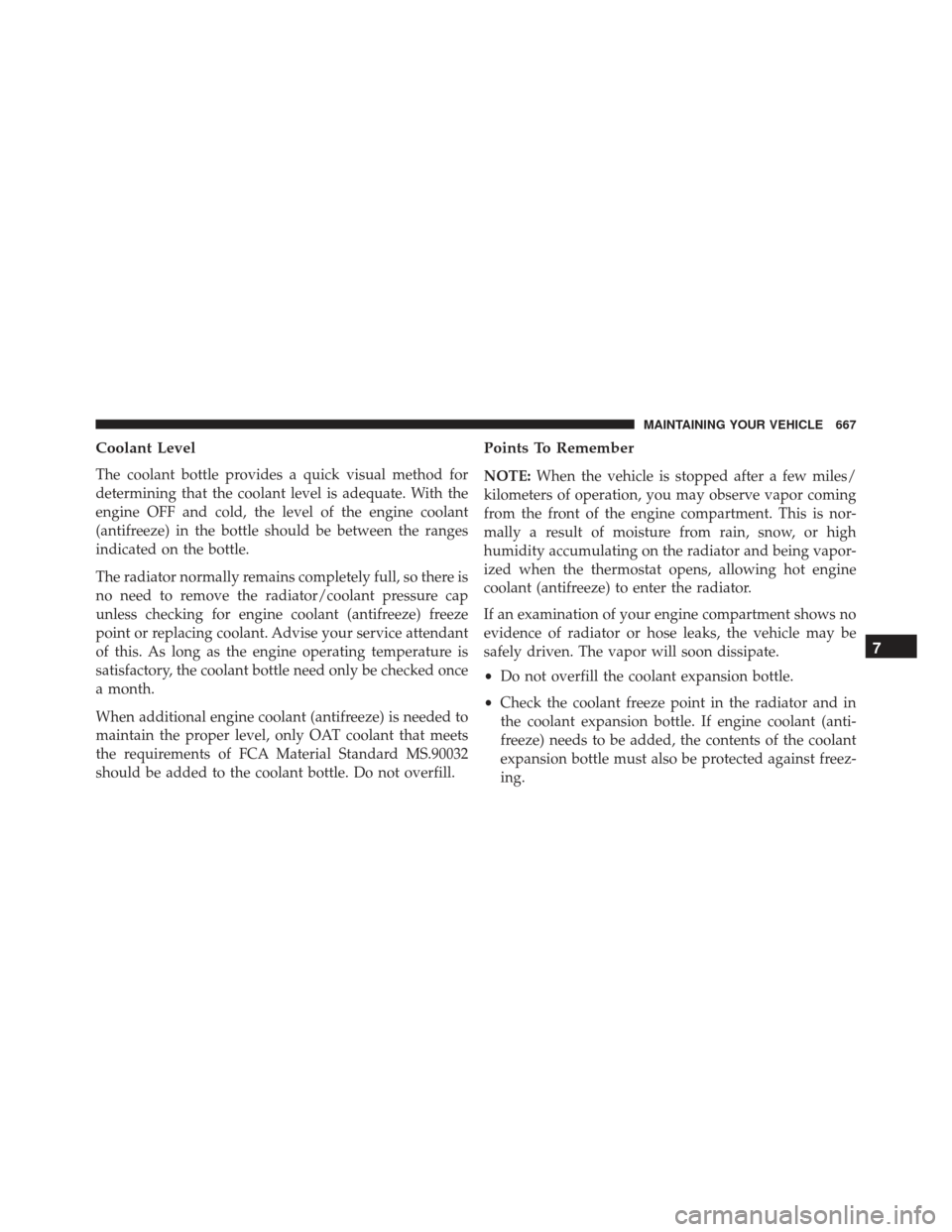
Coolant Level
The coolant bottle provides a quick visual method for
determining that the coolant level is adequate. With the
engine OFF and cold, the level of the engine coolant
(antifreeze) in the bottle should be between the ranges
indicated on the bottle.
The radiator normally remains completely full, so there is
no need to remove the radiator/coolant pressure cap
unless checking for engine coolant (antifreeze) freeze
point or replacing coolant. Advise your service attendant
of this. As long as the engine operating temperature is
satisfactory, the coolant bottle need only be checked once
a month.
When additional engine coolant (antifreeze) is needed to
maintain the proper level, only OAT coolant that meets
the requirements of FCA Material Standard MS.90032
should be added to the coolant bottle. Do not overfill.
Points To Remember
NOTE:When the vehicle is stopped after a few miles/
kilometers of operation, you may observe vapor coming
from the front of the engine compartment. This is nor-
mally a result of moisture from rain, snow, or high
humidity accumulating on the radiator and being vapor-
ized when the thermostat opens, allowing hot engine
coolant (antifreeze) to enter the radiator.
If an examination of your engine compartment shows no
evidence of radiator or hose leaks, the vehicle may be
safely driven. The vapor will soon dissipate.
• Do not overfill the coolant expansion bottle.
• Check the coolant freeze point in the radiator and in
the coolant expansion bottle. If engine coolant (anti-
freeze) needs to be added, the contents of the coolant
expansion bottle must also be protected against freez-
ing.
7
MAINTAINING YOUR VEHICLE 667
Page 700 of 745
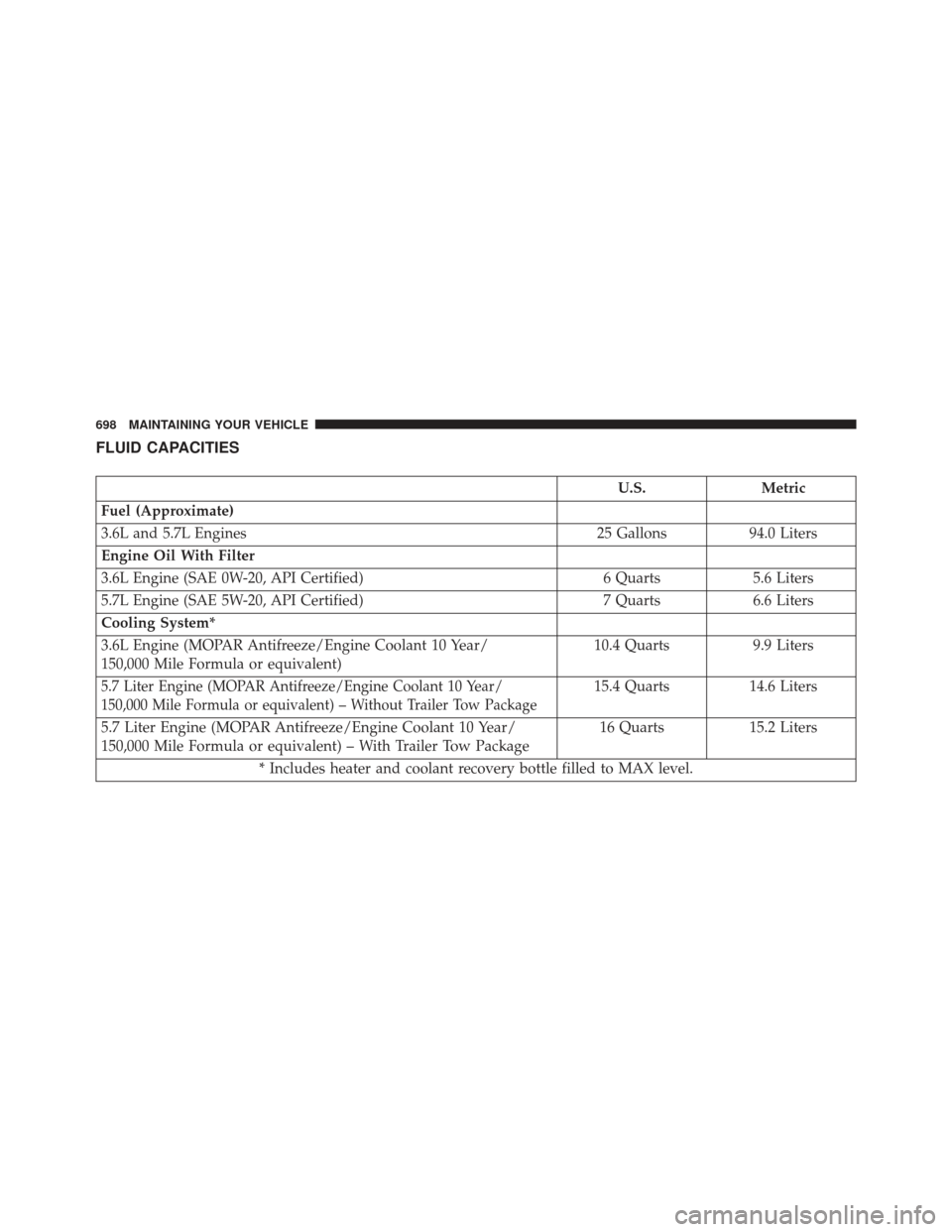
FLUID CAPACITIES
U.S.Metric
Fuel (Approximate)
3.6L and 5.7L Engines 25 Gallons94.0 Liters
Engine Oil With Filter
3.6L Engine (SAE 0W-20, API Certified) 6 Quarts5.6 Liters
5.7L Engine (SAE 5W-20, API Certified) 7 Quarts6.6 Liters
Cooling System*
3.6L Engine (MOPAR Antifreeze/Engine Coolant 10 Year/
150,000 Mile Formula or equivalent) 10.4 Quarts
9.9 Liters
5.7 Liter Engine (MOPAR Antifreeze/Engine Coolant 10 Year/
150,000 Mile Formula or equivalent) – Without Trailer Tow Package15.4 Quarts14.6 Liters
5.7 Liter Engine (MOPAR Antifreeze/Engine Coolant 10 Year/
150,000 Mile Formula or equivalent) – With Trailer Tow Package 16 Quarts
15.2 Liters
* Includes heater and coolant recovery bottle filled to MAX level.
698 MAINTAINING YOUR VEHICLE
Page 707 of 745
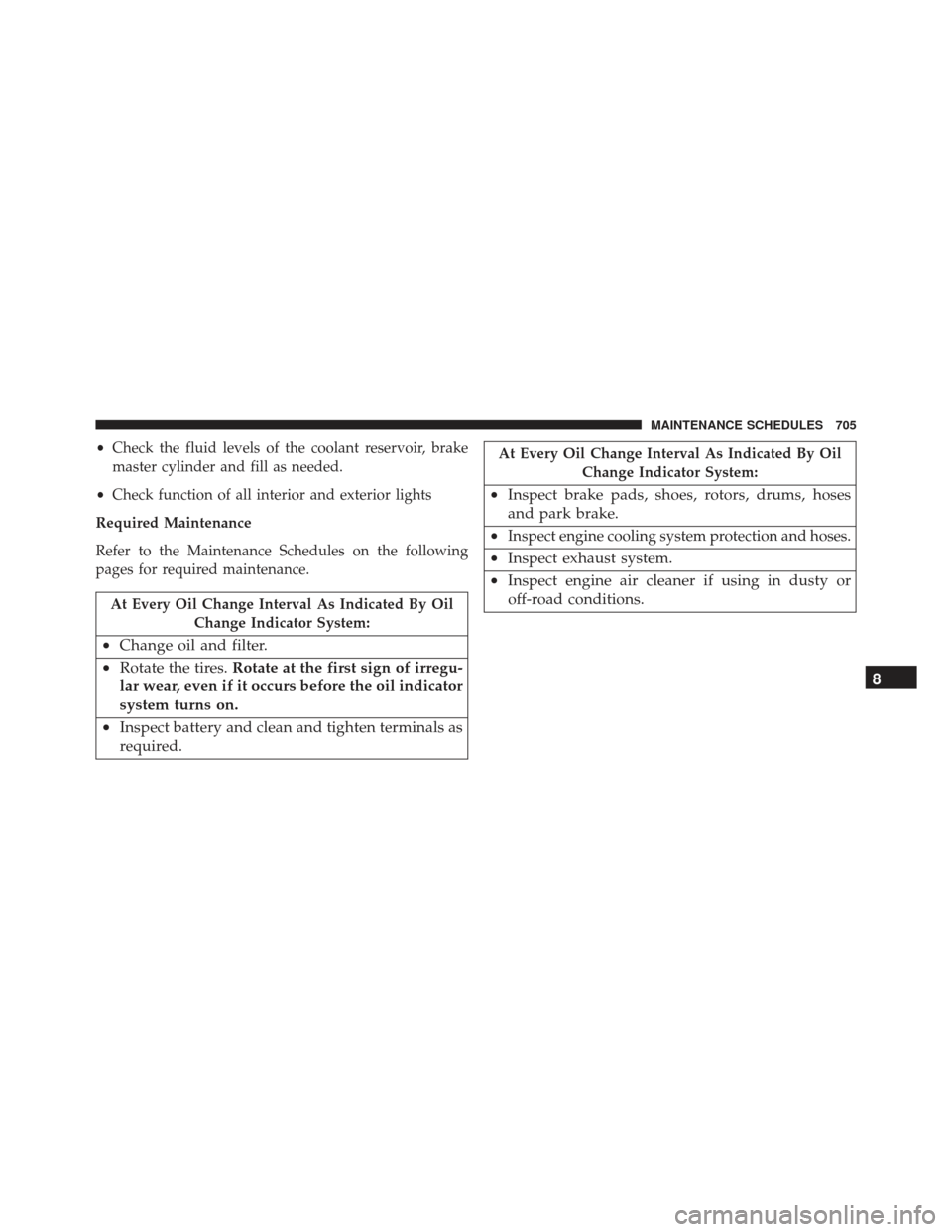
•Check the fluid levels of the coolant reservoir, brake
master cylinder and fill as needed.
• Check function of all interior and exterior lights
Required Maintenance
Refer to the Maintenance Schedules on the following
pages for required maintenance.
At Every Oil Change Interval As Indicated By Oil Change Indicator System:
•Change oil and filter.
• Rotate the tires. Rotate at the first sign of irregu-
lar wear, even if it occurs before the oil indicator
system turns on.
• Inspect battery and clean and tighten terminals as
required.
At Every Oil Change Interval As Indicated By Oil
Change Indicator System:
•Inspect brake pads, shoes, rotors, drums, hoses
and park brake.
•
Inspect engine cooling system protection and hoses.
• Inspect exhaust system.
• Inspect engine air cleaner if using in dusty or
off-road conditions.
8
MAINTENANCE SCHEDULES 705
Page 725 of 745
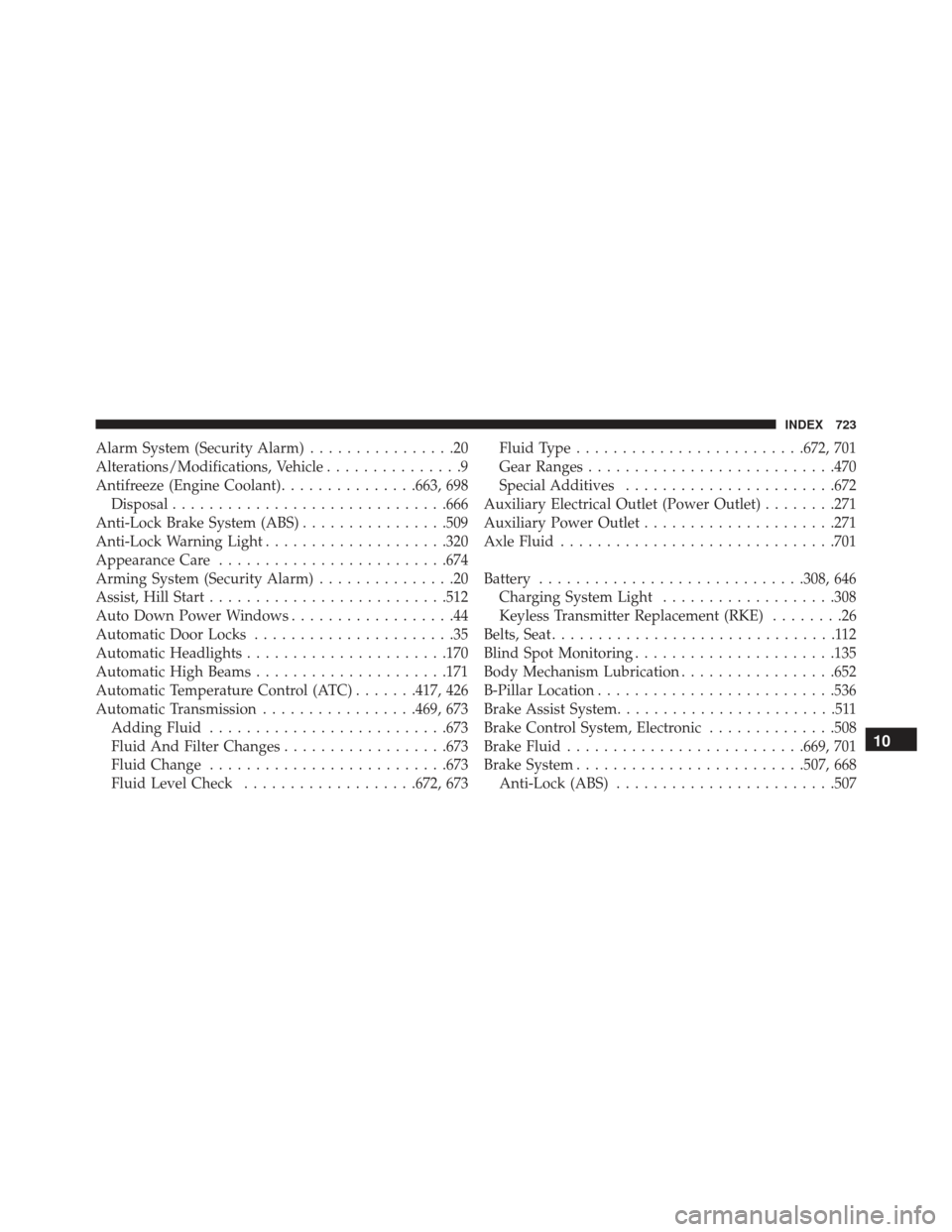
Alarm System (Security Alarm)................20
Alterations/Modifications, Vehicle ...............9
Antifreeze (Engine Coolant) ...............663, 698
Disposal ............................. .666
Anti-Lock Brake System (ABS) ................509
Anti-Lock Warning Light ....................320
Appearance Care ........................ .674
Arming System (Security Alarm) ...............20
Assist, Hill Start ......................... .512
Auto Down Power Windows ..................44
Automatic Door Locks ......................35
Automatic Headlights ..................... .170
Automatic High Beams .....................171
Automatic Temperature Control (ATC) .......417, 426
Automatic Transmission .................469, 673
Adding Fluid ......................... .673
Fluid And Filter Changes ..................673
Fluid Change ......................... .673
Fluid Level Check ...................672, 673 Fluid Type
........................ .672, 701
Gear Ranges .......................... .470
Special Additives ...................... .672
Auxiliary Electrical Outlet (Power Outlet) ........271
Auxiliary Power Outlet .....................271
Axle Fluid ............................. .701
Battery ............................ .308, 646
Charging System Light ...................308
Keyless Transmitter Replacement (RKE) ........26
Belts, Seat ...............................112
Blind Spot Monitoring ..................... .135
Body Mechanism Lubrication .................652
B-Pillar Location ......................... .536
Brake Assist System ........................511
Brake Control System, Electronic ..............508
Brake Fluid ......................... .669, 701
Brake System ........................ .507, 668
Anti-Lock (ABS) ....................... .507
10
INDEX 723
Page 727 of 745
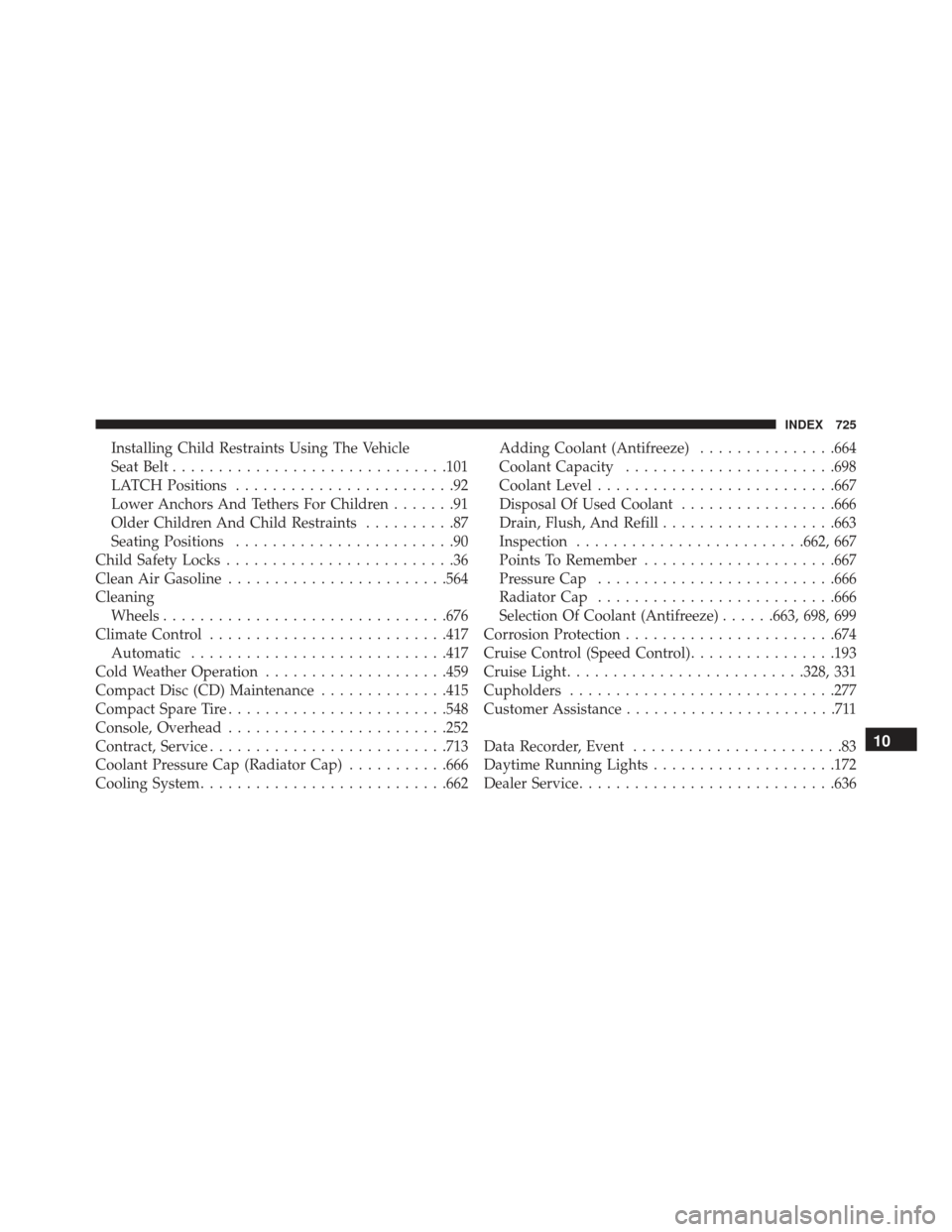
Installing Child Restraints Using The Vehicle
Seat Belt............................. .101
LATCH Positions ........................92
Lower Anchors And Tethers For Children .......91
Older Children And Child Restraints ..........87
Seating Positions ........................90
Child Safety Locks .........................36
Clean Air Gasoline ....................... .564
Cleaning Wheels .............................. .676
Climate Control ......................... .417
Automatic ........................... .417
Cold Weather Operation ....................459
Compact Disc (CD) Maintenance ..............415
Compact Spare Tire ....................... .548
Console, Overhead ....................... .252
Contract, Service ......................... .713
Coolant Pressure Cap (Radiator Cap) ...........666
Cooling System .......................... .662Adding Coolant (Antifreeze)
...............664
Coolant Capacity ...................... .698
Coolant Level ......................... .667
Disposal Of Used Coolant .................666
Drain, Flush, And Refill ...................663
Inspection ........................ .662, 667
Points To Remember .....................667
Pressure Cap ......................... .666
Radiator Cap ......................... .666
Selection Of Coolant (Antifreeze) ......663, 698, 699
Corrosion Protection ...................... .674
Cruise Control (Speed Control) ................193
Cruise Light ......................... .328, 331
Cupholders ............................ .277
Customer Assistance .......................711
Data Recorder, Event .......................83
Daytime Running Lights ....................172
Dealer Service ........................... .636
10
INDEX 725